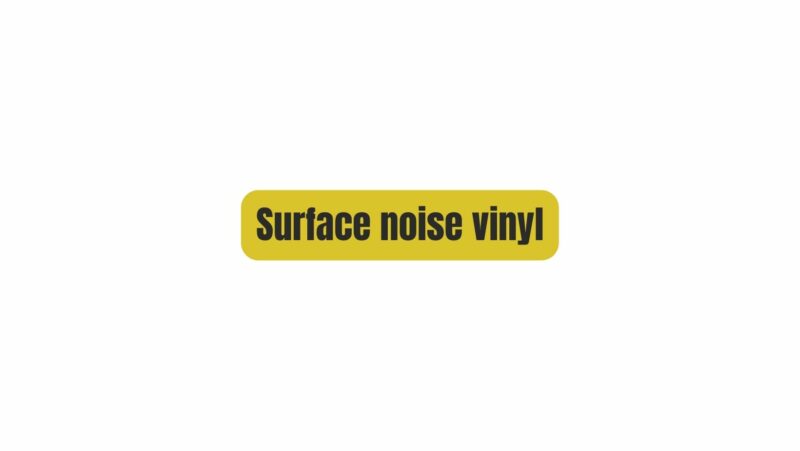Vinyl records have enjoyed a remarkable resurgence in popularity, captivating music enthusiasts with their rich, analog sound and tangible connection to music’s past. The tactile experience of handling a vinyl record, setting it on a turntable, and dropping the stylus onto the grooves is a cherished ritual. However, despite the vinyl’s charm and allure, many listeners are familiar with an age-old nemesis: surface noise.
Surface noise, encompassing pops, clicks, crackles, and hisses, can mar the listening experience, interrupting the seamless flow of music. In this article, we’ll take an in-depth look at surface noise on vinyl records, exploring the causes behind it, its impact on the listening experience, and practical solutions for minimizing and managing it.
Section 1: Understanding Surface Noise
1.1. The Nature of Surface Noise
To comprehend surface noise, we must first understand how vinyl records work. Vinyl records store music in analog form, with sound waveforms etched into grooves on the record’s surface. A stylus follows these grooves, translating the physical movements into sound waves. This delicate process is susceptible to various factors that contribute to surface noise.
1.2. Types of Surface Noise
Surface noise is a collective term that encompasses different types of unwanted sounds during vinyl playback:
- Pops and Clicks: Sudden, sharp sounds caused by dust, dirt, or imperfections in the grooves.
- Crackles: Continuous, fine noises often attributed to wear and tear on the record or stylus.
- Hisses: Background noise, akin to tape hiss, originating from factors like static electricity or record material.
Section 2: The Culprits Behind Surface Noise
2.1. Dust and Dirt
Dust and dirt are frequent contributors to surface noise. Even seemingly clean records can harbor microscopic particles in the grooves. When the stylus encounters these particles, it results in pops, clicks, and crackles. Regular cleaning is vital to minimizing this source of noise.
2.2. Wear and Tear
Vinyl records are not immune to wear and tear. With each playback, the stylus exerts pressure on the grooves, leading to microscopic damage. Over time, this wear accumulates, increasing surface noise and diminishing sound quality. Proper handling, storage, and maintenance can help mitigate this issue.
2.3. Record Quality
The quality of the vinyl record itself plays a significant role in surface noise. Poorly manufactured records may have more imperfections, such as bumps or irregularities in the groove. These imperfections can lead to increased noise during playback. Investing in well-pressed records from reputable labels can help mitigate this issue.
2.4. Static Electricity
Static electricity can generate surface noise by attracting dust and causing pops and crackles during playback. Anti-static measures, including brushes, mats, and controlled humidity levels, can minimize this source of noise.
Section 3: Mitigating and Managing Surface Noise
3.1. Stylus Condition
The condition of the turntable’s stylus is crucial for sound quality and noise reduction. A worn or damaged stylus can introduce noise, including crackling. Regularly inspecting and maintaining your stylus ensures optimal performance.
3.2. Turntable Setup and Calibration
A poorly calibrated turntable can exacerbate surface noise issues. Incorrect tracking force, tonearm balance, and anti-skating settings can stress the grooves and introduce noise. Properly setting up and calibrating your turntable is essential for minimizing surface noise.
3.3. Record Cleaning
Regular record cleaning is fundamental to reducing surface noise. Various cleaning methods, including manual brushes, liquid solutions, and record cleaning machines, can remove dust, dirt, and contaminants from grooves, leading to a cleaner, quieter listening experience.
3.4. Environmental Factors
Environmental conditions can influence surface noise. High humidity can promote mold growth on records, causing damage and adding noise. Conversely, excessively dry conditions can increase static electricity. Maintaining a stable, suitable environment for your vinyl collection is essential for long-term preservation.
Section 4: Embracing the Vinyl Experience
4.1. Vintage Charm
It’s important to note that some degree of noise is inherent in vinyl records due to their analog nature. Analog noise, such as a faint hiss and crackle, is part of the vinyl experience, often appreciated for its warmth and character. Accepting these imperfections can enhance your appreciation of vinyl’s unique charm.
Section 5: Conclusion
In conclusion, surface noise on vinyl records is a challenge that every vinyl enthusiast faces. However, armed with knowledge and the right tools, you can minimize and manage surface noise, allowing you to fully savor the analog beauty of vinyl. Proper care, maintenance, and attention to detail will not only preserve your vinyl collection but also ensure that each listening session is a pleasurable journey through the world of music, with surface noise fading into the background, leaving the music to take center stage. Embrace the quirks of vinyl and revel in the enduring allure of this timeless format.

